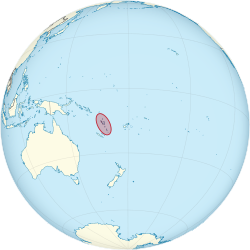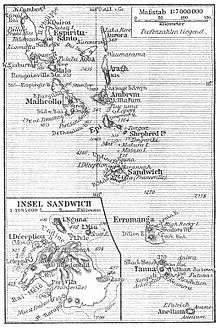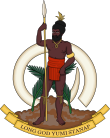New Hebrides
New Hebrides Condominium Condominium des Nouvelles-Hébrides | |||||||||
|---|---|---|---|---|---|---|---|---|---|
| 1906–1980 | |||||||||
 | |||||||||
| Capital | Port Vila | ||||||||
| Common languages | English, French, Bislama | ||||||||
| Government | |||||||||
| Resident Commisoner | |||||||||
| Legislature | Representative Assembly (1975–1980) | ||||||||
| History | |||||||||
• Established | 20 October 1906 | ||||||||
| 30 July 1980 | |||||||||
| Currency | New Hebrides franc, Australian dollar | ||||||||
| |||||||||


New Hebrides, officially the New Hebrides Condominium (
The two countries eventually signed an agreement making the islands an Anglo-French condominium that provided for joint sovereignty over the archipelago with two parallel administrations, one British, one French.[1] In some respects, that divide continued even after independence, with schools teaching in either one language or the other. The condominium lasted from 1906 until 1980, when New Hebrides gained its independence as the Republic of Vanuatu.
Politics and economy
New Hebrides was a rare form of colonial territory in which sovereignty was shared by two powers, Britain and France, instead of being exercised by just one. Under the
The French and British governments were called residencies, each headed by a resident appointed by the metropolitan government. The residency structure greatly emphasised dualism, with both consisting of an equal number of French and British representatives, bureaucrats and administrators. Every member of one residency always had an exact mirror opposite number on the other side whom they could consult. The symmetry between the two residencies was almost exact.
The joint government consisted of both local and European officials. It had jurisdiction over the postal service, public radio station, public works, infrastructure, and censuses, among other things. The two main cities of Luganville and Port Vila also had city councils, but these did not have a great deal of authority.[clarification needed]
While initial settlers were predominantly British living in Australia, the late 19th century saw an influx of French. Within a few decades, there were twice as many French on the islands as there were British, prompting a multitude of petitions to cede power to either the French or the British. Despite this, the two nations came together to form a condominium, a specialised form of government where both nations would have all of their own administrations and jointly rule the islands. The only place they came together was in the Joint Court. As Mander describes, "The Joint Court was the key to the situation and much was to depend upon it….Three judges–one British, one French, and the third nominated by the King of Spain–were to comprise the court."[3] This meant convictions in court were chosen based on either British or French law, depending on the circumstances.
Other than the Joint Court, everything existed in pairs. "Cynics called the Condominium 'the Pandemonium', as the dual administration produced amazing duplication. There were two police forces with their own laws, including road laws, two health services, two education systems, two currencies, and two prison systems."[4] Additionally, there were separate British and French governments, which meant two immigration policies, two courts (apart from the Joint Court), and two corporation laws. Inhabitants of the islands were given the choice of which government they wanted to be ruled by. As Miles put it, "The result was an inevitable clash of foreign policy and colonial mentality."[5]
Local people could choose whether to be tried under the
There were two prison systems to complement the two court systems. The police force was technically unified but consisted of two chiefs and two equal groups of officers wearing two different uniforms. Each group alternated duties and assignments.
Language was a serious barrier to the operation of the naturally inefficient system, as all documents had to be translated once to be understood by one side, then the response translated again to be understood by the other, though Bislama creole represented an informal bridge between the British and the French camps.
The condominium was not beneficial for Ni-Vanuatu, as they were "...officially stateless. [For instance,] To travel abroad, they needed an identifying document signed by both the British and the French resident commissioners."[4] Inevitably, that led to discontent across the islands, with a multitude of revolutionary groups forming in an attempt to create agency and self-government for themselves.
During the
Self-government
New Hebrides became internally self-governing in January 1978.[8]
Chief ministers of the New Hebrides Condominium
- George Kalsakau, November 1977 - December 1978
- Gérard Leymang, December 1978 - November 1979
- Walter Lini, November 1979 - July 1980
See also
- British Empire
- French colonial empire
- List of resident commissioners of the New Hebrides
- Coconut War
- Postage stamps and postal history of Vanuatu
- History of Vanuatu
References
- Notes
- S2CID 201397581.
- ^ "Vanuatu - a brief history from 12 - Vanuatu". RNZ.
- ^ Mander 1944, p. 152
- ^ a b Harewood et al. 2006
- ^ Miles 1994, p. 201
- ISBN 9781925022209. Retrieved 15 March 2015.
- ^ Lindstrom 1991, pp. 49–53.
- JSTOR 25168391.
- Sources
- Harewood, J.; Chinula, T.; Talbot, V.; Carillet, J.-B.; Sorokin, M. (2006). Vanuatu and New Caledonia (1st ed.). Singapore: Lonely Planet.
- Lindstrom, Lamont (1991). "Remembering the Pacific War". Occasional Papers of the Center for Pacific Islands Studies. Center for Pacific Studies: 47–59. ISSN 0897-8905.
- Mander, L. A. (1944). "The New Hebrides Condominium". Pacific Historical Review. 13 (2): 151–167. JSTOR 3634610.
- Miles, W. F. (1994). "Anachronistic Antagonisms: France Versus Britain in the New Hebrides, 1966–1977". Proceedings of the Meeting of the French Colonial Historical Society. 19. Michigan State University Press: 200–215. JSTOR 43007776.
- Peck, John G.; Gregory, Robert J. (2005). "A Brief Overview of the Old New Hebrides" (PDF). The Anthropologist. 7 (4): 269–282. S2CID 56413455. Retrieved 5 February 2008.



